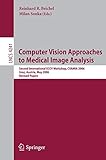Computer Vision Approaches to Medical Image Analysis [electronic resource] : Second International ECCV Workshop, CVAMIA 2006, Graz, Austria, May 12, 2006, Revised Papers / edited by Reinhard R. Beichel, Milan Sonka.
Contributor(s): Beichel, Reinhard R [editor.] | Sonka, Milan [editor.]
| Sonka, Milan [editor.] | SpringerLink (Online service)
| SpringerLink (Online service) .
.
Material type:  BookSeries: Image Processing, Computer Vision, Pattern Recognition, and Graphics: 4241Publisher: Berlin, Heidelberg : Springer Berlin Heidelberg : Imprint: Springer, 2006Edition: 1st ed. 2006.Description: XII, 264 p. online resource.Content type: text Media type: computer Carrier type: online resourceISBN: 9783540462583.Subject(s): Computer vision
BookSeries: Image Processing, Computer Vision, Pattern Recognition, and Graphics: 4241Publisher: Berlin, Heidelberg : Springer Berlin Heidelberg : Imprint: Springer, 2006Edition: 1st ed. 2006.Description: XII, 264 p. online resource.Content type: text Media type: computer Carrier type: online resourceISBN: 9783540462583.Subject(s): Computer visionClinical Applications -- Melanoma Recognition Using Representative and Discriminative Kernel Classifiers -- Detection of Connective Tissue Disorders from 3D Aortic MR Images Using Independent Component Analysis -- Comparing Ensembles of Learners: Detecting Prostate Cancer from High Resolution MRI -- Accurate Measurement of Cartilage Morphology Using a 3D Laser Scanner -- Image Registration -- Quantification of Growth and Motion Using Non-rigid Registration -- Image Registration Accuracy Estimation Without Ground Truth Using Bootstrap -- SIFT and Shape Context for Feature-Based Nonlinear Registration of Thoracic CT Images -- Consistent and Elastic Registration of Histological Sections Using Vector-Spline Regularization -- Image Segmentation and Analysis -- Comparative Analysis of Kernel Methods for Statistical Shape Learning -- Segmentation of Dynamic Emission Tomography Data in Projection Space -- A Framework for Unsupervised Segmentation of Multi-modal Medical Images -- Poster Session -- An Integrated Algorithm for MRI Brain Images Segmentation -- Spatial Intensity Correction of Fluorescent Confocal Laser Scanning Microscope Images -- Quasi-conformal Flat Representation of Triangulated Surfaces for Computerized Tomography -- Bony Structure Suppression in Chest Radiographs -- A Minimally-Interactive Watershed Algorithm Designed for Efficient CTA Bone Removal -- Automatic Reconstruction of Dendrite Morphology from Optical Section Stacks -- Modeling the Activity Pattern of the Constellation of Cardiac Chambers in Echocardiogram Videos -- A Study on the Influence of Image Dynamics and Noise on the JPEG 2000 Compression Performance for Medical Images -- Fast Segmentation of the Mitral Valve Leaflet in Echocardiography -- Three Dimensional Tissue Classifications in MR Brain Images -- 3-D UltrasoundProbe Calibration for Computer-Guided Diagnosis and Therapy.
Medical imaging and medical image analysis are developing rapidly. While m- ical imaging has already become a standard of modern medical care, medical image analysis is still mostly performed visually and qualitatively. The ev- increasing volume of acquired data makes it impossible to utilize them in full. Equally important, the visual approaches to medical image analysis are known to su?er from a lack of reproducibility. A signi?cant researche?ort is devoted to developing algorithms for processing the wealth of data available and extracting the relevant information in a computerized and quantitative fashion. Medical imaging and image analysis are interdisciplinary areas combining electrical, computer, and biomedical engineering; computer science; mathem- ics; physics; statistics; biology; medicine; and other ?elds. Medical imaging and computer vision, interestingly enough, have developed and continue developing somewhat independently. Nevertheless, bringing them together promises to b- e?t both of these ?elds. This was the second time that a satellite workshop,solely devoted to medical image analysis issues, was held in conjunction with the European Conference on Computer Vision (ECCV), and we are optimistic that this will become a tradition at ECCV. We received 38 full-length paper submissions to the second Computer Vision Approaches to Medical Image Analysis (CVAMIA) Workshop, out of which 10 were accepted for oral and 11 for poster presentation after a rigorous peer-review process. In addition, the workshop included three invited talks. The ?rst was given by Maryellen Giger from the University of Chicago, USA - titled "Multi-Modality Breast CADx".


There are no comments for this item.